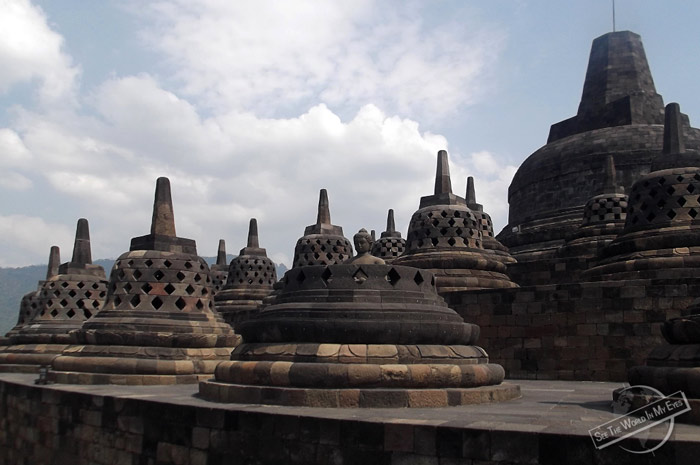Travel Day 687 – Yogyakarta and Borobudur on Java, INDONESIA
In continuation of seeing the historical sites of central Java, today I went to see the Buddhist Borobudur Temple, another UNESCO World Heritage site…
In general, the religious aspect of Indonesia seemed quite interesting as it used to be a Buddhist country at some point. Through the influence of India, Indonesia eventually became Hindu nation, then it became Muslim through the growing Arab influences and later Christian through the European colonizers. Actually the Portuguese brought the Catholic faith first while the Dutch brought later on the Protestant one. The result was that nowadays there was a great mix of religions in Indonesia and each island seemed to be following predominantly one of then…
The Buddhist period seemed quite short-lived and only very few reminders of that time existed. While some Buddhist temples stood in close by Prambanan, Borobudur was by far the biggest monument that was discovered under many layers of volcanic ash and in state of desperate need for restoration. With funding from UNESCO the whole Buddhist temple of Borobudur had been excavated and completely restored. Only one corner at the base of the structure had been removed to expose the original shape and carvings that been overbuilt by a stone encasement at some point…
The fact that Borobudur had been overbuilt and changed a few times made actually sense, because architecturally speaking the current structure did not look very appealing. Actually from the distance the whole temple complex looked like mix between a cut off pyramid and a huge pile of bricks. Only when viewed from a bird’s perspective, the six square terraces plus the three round ones on the top, including the much too small looking stupa in the center, represented the shape of a Buddhist mandala…
But the real beauty of Candi Borobudur didn’t lie so much in shape, but much rather in the details. Built between the 8th and the 9th century, this so to say three-dimensional mandala provided a 5 kilometer long walk through the galleries and along some 2500 carved stone panels depicting entire stories plus 432 separate Buddha statues. In addition to that, 72 bigger Buddhas were sitting on the top, around the central stupa and on the circular three levels, each of them contained in a bell-shaped openwork stupa…
Even if it had never been discovered what the real purpose of the structure was or why the original base with its 160 carved panes had been hidden behind a newer base encasement level, the experience of walking the galleries and seeing all the carvings was really impressive. It didn’t even matter that the mid-day sun was boiling hot and the walk took seemingly forever, but being able to pass through all three represented stages, the world of desires, the world of form and the formless world, was a great experience…
Luckily on the way down it was possible to just take one of the four staircases and then sit in the grass and watch this massive Buddhist temple. Although the form seemed a bit strange and the purpose a mystery, it still had been well worth the effort of taking the local bus over from Yogyakarta. Overall it seemed that between the good local food, the friendly people, the historical sites of the Kraton and the Water Castle plus the UNESCO sites of Prambanan and Borobudur, Yogyakarta really had a lot to offer and it was simply great to explore all of it…



Hi Dennis,
Really amazing to read your adventure, as you know Borobudur Temple is at Magelang and Prambanan is at Klaten Central Java. Yogyakarta is the middle of that city 😀
You will find many temples in around Central Java such are Mendut Temple Mendut,
Pawon Temple, Ratu Boko Temple, Kalasan Temple and many more.
You will never thing that Java is places of temples 😀
Thank you Analisa for pointing out that there are so many more temples to see on Java! I was very happy to visit Borobudur and Prambanan, but if I will go again to Java, It will make sure to explore even more around Yogyakarta…